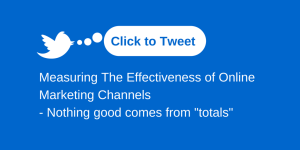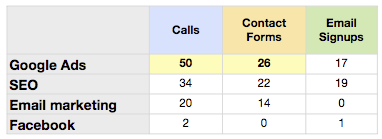In my previous article I showed several ways to measure the effectiveness of your site using web analytics. Now we want to apply those same lessons to our online marketing campaigns.
Nothing good can come of “totals.”
First, a golden rule: never view, analyze, or assess your site by looking at total visits, total uniques, or total pageviews. Nothing good can come of “totals.” Nothing, zip, nada.
The makeup of your visitors is diverse both in how they found you and what they know about your business. They may have come via online marketing, offline marketing or word of mouth. They may be a current customer or a lead who has been in your sales funnel for several months. To gain true understanding and to take real action, we need to separate your traffic. Today, we’ll separate various online marketing campaigns.
Start By Creating Your Scoreboard:
Your site’s scoreboard should be able to tell you everything you need to know about your traffic in one page. In the far left column are your different marketing campaigns. This may include your SEO (search engine optimization), Facebook campaigns, Google advertising, and email marketing traffic. Along the top are the different goals or outcomes you want people to take once they arrive on your site. It should look something like this:
This is now the basic framework. Now let’s fill it in.
Goal Completions:
This gives us the number of times traffic from a particular source completed a particular goal. This part of the scoreboard answers the “how much?” question. While it’s not great for deep analysis, this metric is helpful for keeping your finger on the pulse of what happens day-to-day. Adding this column to the chart above, we get something like this:
Observations:
If this were our only data, we’d conclude Google Advertising is the best campaign for generating leads, simply because it produces more than any other channel.
Conversion Rate:
Only reporting goal completions, as shown above, can be misleading because the number of visitors coming from each campaign can vary greatly. Conversion rate solves this problem.
Conversion rate tell us how effective each campaign is at completing our site’s goals. It’s calculated as (number of goal completions / number of visitors). All else being equal, this metric tells us which campaign is most effective at generating leads. Adding conversion rate to the chart above, we might get this result:
Observations:
The story is beginning to shift. While Google Advertising was effective at generating the most calls and contact submissions, it does so at a lower rate compared to other campaigns. Meanwhile, SEO and email marketing are beginning to look more attractive.
Cost Per Conversion:
Given the choice of one metric for measuring an online marketing campaign, I would choose “cost-per-conversion” almost every time. It’s one of the best ways to measure true impact because it takes into account the financial investment. Cost-per-conversion is simply (investment / number of conversions).
Conclusion:
The story continues to evolve! Email marketing is by far our most cost-effective channel. This might lead us to increase the frequency of email blasts or the budget we set aside for email development next month. It also might affect our perceived value of SEO. While the cost per lead was more expensive for SEO, it was very good at capturing email addresses - something that suddenly holds more value than we previously thought.
To get the most for our marketing dollar, we should think of managing our campaigns as though we’re buying wins. By identifying the channel with the lowest cost-per-conversion (the least expensive “win”), we will have a clear indication of where future investments should be made.
At WebStrategies, Inc, we analyse all the data to find out how your customer find you, and which ones take the actions you want (buy, call, download, etc.). Learn more about how we use web analytics to learn who, when, where, and how potential customers find and use your online channels.
Have you recently discovered any revelations from analyzing of your online marketing data? Share you stories in the comments section below.
You may also be interested in ...
Web Analytics – Creating a Foundation for Marketing Success
Google Analytics – Back To The Basics pt. 1
Google Analytics – Back To The Basics pt. 2 – Advanced Segments
Back to the Basics, III: Using Google Analytics Custom Reports










Agree, disagree, or just have something to add?
Leave a comment below.